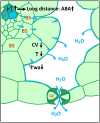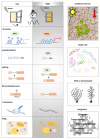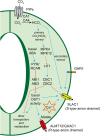Burning questions for a warming and changing world: 15 unknowns in plant abiotic stress
- PMID: 36018271
- PMCID: PMC9806664
- DOI: 10.1093/plcell/koac263
Burning questions for a warming and changing world: 15 unknowns in plant abiotic stress
Abstract
We present unresolved questions in plant abiotic stress biology as posed by 15 research groups with expertise spanning eco-physiology to cell and molecular biology. Common themes of these questions include the need to better understand how plants detect water availability, temperature, salinity, and rising carbon dioxide (CO2) levels; how environmental signals interface with endogenous signaling and development (e.g. circadian clock and flowering time); and how this integrated signaling controls downstream responses (e.g. stomatal regulation, proline metabolism, and growth versus defense balance). The plasma membrane comes up frequently as a site of key signaling and transport events (e.g. mechanosensing and lipid-derived signaling, aquaporins). Adaptation to water extremes and rising CO2 affects hydraulic architecture and transpiration, as well as root and shoot growth and morphology, in ways not fully understood. Environmental adaptation involves tradeoffs that limit ecological distribution and crop resilience in the face of changing and increasingly unpredictable environments. Exploration of plant diversity within and among species can help us know which of these tradeoffs represent fundamental limits and which ones can be circumvented by bringing new trait combinations together. Better defining what constitutes beneficial stress resistance in different contexts and making connections between genes and phenotypes, and between laboratory and field observations, are overarching challenges.
© The Author(s) 2022. Published by Oxford University Press on behalf of American Society of Plant Biologists.
Figures














References
-
- Abdalla M, Carminati A, Cai GC, Javaux M, Ahmed MA (2021) Stomatal closure of tomato under drought is driven by an increase in soil–root hydraulic resistance. Plant Cell Environ 44: 425–431 - PubMed
-
- Agrawal AA (2020) A scale-dependent framework for trade-offs, syndromes, and specialization in organismal biology. Ecology 101: e02924. - PubMed
-
- Agrawal AA, Conner JK, Rasmann S (2010) Tradeoffs and negative correlations in evolutionary ecology. InEvolution Since Darwin: The First 150 Years. Sinauer Association, Sunderland, MA, pp 243–268.
-
- Abiko T, Kotula L, Shiono K, Malik AI, Colmer TD, Nakazono M (2012) Enhanced formation of aerenchyma and induction of a barrier to radial oxygen loss in adventitious roots of Zea nicaraguensis contribute to its waterlogging tolerance as compared with maize (Zea mays ssp. mays). Plant Cell Environ 35: 1618–1630 - PubMed
Publication types
MeSH terms
Substances
Grants and funding
LinkOut - more resources
Full Text Sources
Other Literature Sources
Medical

